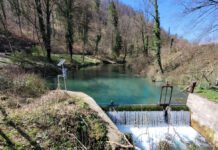
The Environment Agency has published its mid-programme report, detailing the benefits the agency says are accruing from various schemes undertaken to support flood and coastal resilience.
Published on 28 October, the report reviews the EA’s £200 million Flood and Coastal Innovation Programmes, and approaches to flood and coastal resilience taken by the agency, local authorities and local partners.
Advancements listed include:
- 97 new natural flood management schemes delivered, using natural processes to slow the flow of floodwaters through techniques such as leaky dams, wetland ponds and enhanced marine habitats;
- Almost 600 new monitoring sensors around the country to measure river levels and provide accurate and timely warnings ahead of flooding;
- 25 PhD positions funded to train the next generation of flood experts and develop new approaches to the challenges of climate change and extreme weather.
The three programmes, which cover 35 projects across 30 local authorities, receiving funding between 2021 and 2027 include:
- the £150 million Flood and Coastal Resilience Innovation Programme, which is testing and implementing practical and innovative actions across 25 local authority projects to improve resilience to flooding and coastal erosion.
- the £36 million Coastal Transition Accelerator Programme, which supports communities and businesses at risk of coastal erosion to transition and adapt to a changing coast. Projects have already started in East Riding of Yorkshire and North Norfolk, while the programme has recently been expanded to include additional, smaller projects in Bude in Cornwall and Charmouth and Swanage in Dorset.
- the £8 million Adaptation Pathways Programme, which is developing adaptation pathway plans in locations of national significance, helping local places to better plan for and adapt to future flooding and coastal change. Projects working on long term planning for climate adaptation are being undertaken in the Thames and Humber estuaries, the Severn Valley and Yorkshire.
The remaining funds are used to provide strategic support for the innovation programme projects and to evaluate the benefits of the programmes.
Hannah Bartram, Chief Executive of ADEPT, said: “As part of this work, we recently held three Rapid Adaptation Pathways Assessment workshops across the country, helping those local authorities assess their future flood risks and build adaptive strategies. This highlighted the importance of collaborative and innovative forward-thinking to safeguard communities and ensure the resilience of key assets.
“The commitment shown by the local authorities involved demonstrates that when given the space and freedom to innovate, local authorities truly thrive in addressing complex environmental challenges.”
Andrew Cook, Executive Director for Growth, Highways and Infrastructure at Suffolk County Council, said: “The challenges we all face to effectively manage flood risk and coastal erosion are significant, and only going to increase with impacts of climate change.
“This is why the Environment Agency’s Flood & Coastal Innovation Programmes are so important, for giving practitioners in local authorities across England the opportunity to test new approaches, challenge preconceptions and collaborate to collect the evidence that can inform the new policy and practice.
“I am very encouraged by the progress being made at this mid-way point and excited to see the results for projects like Suffolk’s Reclaim the Rain as they work towards completion.”
Some examples of individual initiatives supported through these programmes include:
- The Action for Silk Stream project team in Watling Park in the London Borough of Barnet has partnered with the police to align its sensitive landscape design with public realm improvements. The aim is not only to reduce flood risk, but to create safer and more accessible public spaces by tackling anti-social behaviour and crimes, especially those against women.
- Elsewhere, the Resilient Roch project in Rochdale is combining property flood resilience and energy efficiency measures to retrofit social housing targeted at disadvantaged communities in Littleborough and Wardleworth. The local authority has aligned funding from a package of energy efficiency measures of around £3 million with Ovo Energy to provide practical flood resilience and energy efficiency advice, helping to boost resilience and save money for householders.
And, says the EA report, the projects have also found ways of maximising the benefits of nature-based solutions to deliver wider benefits to the environment and support the local economy by using nature to safeguard tourism and enable new industries.
- In South Tyneside, the Stronger Shores team are embracing nature-based solutions by establishing seagrass meadows, kelp forests, and oyster reefs. In certain conditions, kelp forests can lower wave energy by up to 50%, reducing the erosive power of wave action at the shore. They also have carbon sequestration benefits. The team is partnering with academia to understand how such measures can reduce coastal erosion and deliver local economic benefits from an improved marine environment.
The £200m fund was launched in 2020 to meet the aims of the Environment Agency’s Flood and Coastal Erosion Risk Management (FCERM) Strategy for England.






